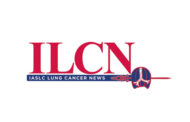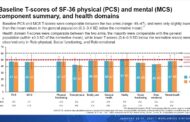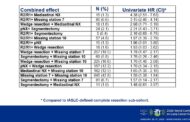Editor’s Note: This interview first aired on Lung Cancer Considered on April 19. What follows is the first half of the interview—a discussion of the ALINA trial—between Lung Cancer Considered host Narjust Florez, MD, and investigator Benjamin Solomon, MBBS, FRACP, PhD. The interview has been edited slightly for length and clarity. Look for part 2 in the coming weeks in ILCN. For more information on the ALINA trial and the subsequent approval of alectinib as adjuvant treatment for ALK-positive non-small cell lung cancer, see ALINA Trial Leads to New Treatment Option for Early-Stage ALK+ NSCLC.

Dr. Florez: Welcome to Lung Cancer Considered. I’m Dr. Narjust Florez, Associate Director of the Cancer Care Equity Program at Dana-Farber Cancer Institute, an Assistant Professor of Medicine at Harvard Medical School, and your host for this episode of Lung Cancer Concerned.
Today I’m joined by a leader in the field of thoracic oncology, particularly in ALK-positive non-small cell lung cancer. We’ll be discussing groundbreaking data from the ALINA trial, which was presented at the 2023 European Society for Medical Oncology (ESMO) Annual Meeting. It is my pleasure to introduce Dr. Benjamin Solomon. Prof. Solomon is a clinician-scientist at Peter MacCallum Cancer Center in Victoria, Australia, whose clinical and translational research has identified new treatments, changed the standards of care, and improved outcomes for patients with lung cancer. His work has resulted in regulatory approvals for first, second, and third-line ALK-TKIs. He has defined new and transformative standards of care in this population. Welcome to Lung Cancer Considered, Dr. Solomon.
I would like to set the stage for our audience. ALK is a tyrosine kinase that can be overly expressed in several tumor types, including lung cancer. Tumors that contain the ALK fusion oncogene, all these variants, are associated with specific clinical features, including never or light tobacco users and younger age. Although, these typical characteristics are not actually required to be fulfilled for the diagnosis of ALK-rearranged lung cancer. Testing for this fusion gene in non-small cell lung cancer is important as patients with this rearrangement are highly sensitive to ALK-targeted inhibitors. Ben, what are some of the unique characteristics of ALK-positive disease that are important when developing neoadjuvant therapy?

Dr. Solomon: As you say, there are some unique clinical features about ALK-rearranged lung cancer that we’ve learned from the metastatic setting. You mentioned the demographics; the younger age, the non-smoking history, but another factor that’s important is the propensity for brain metastases. In the advanced setting, we see brain metastases in 20 to 30% of patients at diagnosis and an increasing frequency over time. When we are thinking about treatments for the early stage, we know that we can think about how to move the advances we’ve seen in the late-stage setting—where ALK-tyrosine kinase inhibitors have transformed outcomes—into this population into the early stage.
In the early-stage, we know that the advances in immunotherapy that we’ve seen in both the neoadjuvant and adjuvant setting don’t really seem to apply to patients with oncogene-driven cancers such as EGFR or ALK gene rearrangements. We know that the benefits of standard adjuvant chemotherapy are very modest, with only a 5% absolute survival benefit seen with adjuvant platinum-based chemotherapy. So, we need more effective treatments, and we need treatments that are also effective at controlling and preventing brain metastases in this setting.
Dr. Florez: Thank you so much, Ben. That’s very important because when patients have CNS recurrence or CNS progression, it is life-changing. The treatments can be very challenging, and these are younger patients, so many of them cannot continue to work or care for their children. I think whatever we can do to reduce that risk is so significant.
Dr. Solomon: Absolutely. It’s not just a point on a progression-free survival curve. The incidence of brain metastases, as you say, has a massive impact on a patient who might need to drive their children to school but is no longer able to drive because of brain metastases.
Dr. Florez: As we continue the discussion, we have several agents that we’re using in patients with metastatic ALK-positive non-small cell lung cancer. Now we’re moving these agents to early stage. What is important to move these target agents to early stage, and what are some of the characteristics of these new generations of agents?
Dr. Solomon: Firstly, I think these agents must be highly effective. We know from studies done in the advanced setting that ALK inhibitors, and particularly the newer generation inhibitors, are super effective at controlling disease and certainly much better than chemotherapy. We also need them to be—as we mentioned before—active in the brain because this is an important site of disease recurrence in patients after surgery. We need to have agents that can protect the brain. Almost as important is that these agents be tolerable over the long-term because with adjuvant tyrosine kinase inhibitors, the duration of therapy is several years. So, efficacy, CNS efficacy, and tolerability are the key characteristics I think that we need.
Dr. Florez: Can you please walk us through the design of the ALINA study?
Dr. Solomon: The ALINA trial was an open-label randomized study. It was conducted at 113 centers in 26 countries, so real global effort. In this study, patients with completely resected stage IB to IIIA non-small cell lung cancer that had tested positive in an ALK rearrangement by an approved local test were eligible for treatment. Then these patients were randomized in a 1:1 ratio to treatment with either standard of care therapy, which was four cycles of platinum-based chemotherapy, or to treatment with 2 years of alectinib given at a dose of 600 milligrams twice-daily.
Stratification factors were age, stage, and ethnicity. The primary endpoint of the study was disease-free survival by investigator assessment. This was tested hierarchically, first in the stage II to IIIA population, and then in the intent-to-treat population, which was the IB to IIIA population. Key secondary endpoints were CNS efficacy, overall survival, and safety. Two hundred fifty-seven patients were randomized and characteristics were generally balanced between the groups, although there were slightly more females and never-smokers in the alectinib arm compared to the chemotherapy arm.
I think one interesting factor was that about 50% of the patients had N2 disease, which was often unsuspected prior to surgery. In terms of outcomes of the study, the study was positive for its primary endpoint at the first planned interim analysis, which was presented at the ESMO meeting last year. The study was positive in the intent-to-treat population with a pretty impressive hazard ratio of 0.24, I think.
The median disease-free survival in the patients receiving chemotherapy was 41.3 months. In patients receiving alectinib, the median disease-free survival has not yet been reached. The 3-year point estimates for disease-free survival were 88.7% for alectinib compared to 54% for chemotherapy. Really, benefit was seen in all the subgroups that were looked at. We can come back to the details of the different subgroups, but I just wanted to draw attention to the CNS efficacy because we talked about the importance of brain control.
In this study, we paid particular attention to the brain and required MRI scans at baseline and at each disease assessment, so we were able to get a pretty good picture for control in the brain. The hazard ratio for CNS disease-free survival was 0.2 in favor of alectinib. In terms of CNS recurrences, there were 14 CNS recurrences in the chemotherapy group compared to four in the alectinib group, indicating the ability of alectinib to control brain disease.
Dr. Florez: …I think it’s a very impressive hazard ratio. We’re talking about a difference of not reached versus 44.4 months, and the 3-year disease-free survival, there is over 30% difference between one group and the other… I couldn’t attend ESMO, but I was thinking, “I’m missing this history-changing presentation. I want to be in the room there.” So how was it when you were presenting this data? Was there silence after you showed those graphs?
Dr. Solomon: …I think there was a real sense of positivity and optimism from the audience. There was a great reception to the data, and it was thrilling to have the opportunity to see and to present the first study where we’ve really seen the big impact TKIs have in the advanced setting. To see that this translates to the early-stage setting was such a thrill and a real privilege to be able to present.
Dr. Florez: A question and a comment I have is about subsequent lines of therapy. So Ben, how many patients were able to receive subsequent therapy, and which were the most common therapies for the patients that went on next line or went on another agent?
Dr. Solomon: I think that is an important question when we’re looking at adjuvant studies, and there’s been a lot of discussion about that in the context of ADAURA and appropriately so. In the ALINA study, of the patients that developed recurrence on chemotherapy, 76% of them received subsequent treatment with an ALK-tyrosine kinase inhibitor. The majority received alectinib. Of the remainder, I think it’s important to note that some of these patients went on to receive surgery or radiotherapy, so it’s not as though they didn’t receive a subsequent treatment, and some of them may have had attempts at salvage surgery or radiotherapy. It’s also important to point out that the ALINA study was conducted in countries that had approved ALK inhibitors available at subsequent therapies.
Dr. Florez: I think that’s very important because when we don’t have crossover, we may influence the perceptions of the trial. I also think there is an ethical piece. As a person that studies equity, I think it is fair that people are allowed to go on the latest and greatest treatment, if possible. As we continue to discuss the study design, I cannot help but ask about the future of the data to be presented? Should we expect overall survival data in a year? Or 2 years?
Dr. Solomon: I think here we’re a little bit fortunate in having the experience of the ADAURA study with adjuvant osimertinib in resected EGFR mutation-positive lung cancer, where we saw that a big difference in disease-free survival reported earlier. I remember hearing an excellent interview that you did with Roy Herbst about his original presentation of the ADAURA data when he presented a big disease-free survival benefit… Then, just last year, he presented the overall survival data, and the big disease-free survival translated to an overall survival benefit.
I think we’ll need time to tell if that’s the case with the ALINA study. My suspicion is that something similar will play out. In terms of how long it takes for us to see the survival benefit, I think that is less clear because we know that in the advanced setting, ALK-TKIs have such a big impact on survival in ALK-positive non-small cell lung cancer with median survivals in excess of 5 years. I think we might be waiting a while to see the survival data mature, but my hunch is that it will reflect what we’ve seen with the ADAURA study.




